Tweeks: Black Canary Vs Scarlet Witch
This week we battle it out to see whose favorite super heroine is the best. Maddy brings her favorite DC Superhero Black Canary to the fight against Anya’s favorite Marvel Superhero Scarlet Witch.
This week we battle it out to see whose favorite super heroine is the best. Maddy brings her favorite DC Superhero Black Canary to the fight against Anya’s favorite Marvel Superhero Scarlet Witch.
If there every were a set of sister cooler than The Tweeks, it would have to be Shawna & Julie Benson. There, we said it! And it’s so true. They are the absolute coolest & nicest & most talented!
For those of you who haven’t been waiting (im)patiently for the release of DC’s Rebirth Batgirl & The Birds of Prey, let us briefly explain how awesome it is.
The Birds of Prey are a team of female superheroes who team up to fight villains. The team consists of Barbara Gordon, Black Canary, and Huntress, as well as a few girls who pop in to help out sometimes (though not in this latest one). The comic was revamped for DC’s Rebirth and was released yesterday. So, off you go to the comic book store or to download it, whatevs, just do it. The Birds of Prey are one of Maddy’s all time favorites, so according to Maddy, it’s even better than Tweeks Approved!
Anyway, back to The Benson sisters! They wrote the comic (among all sorts of other stuff, google them) & Maddy had a chance to talk to both Shawna & Julie about these fantastic ladies. In this interview, you’ll find out about what we can expect from the Birds, what’s up with Barbara Gordon/Oracle, some possible special guests, and then we talk about guacamole and leather jackets and nail polish.
The Benson sisters also are both, no surprise, Team Maddy.
THE BLACK CANARY LADY SINGS THE BRUISE
Now there’s a lawsuit waiting to happen.
Or three.
Dinah Drake, who when she’s wearing her super heroine costume and not her street clothes goes by the name Black Canary, found a new job in Black Canary vol.4 #1. 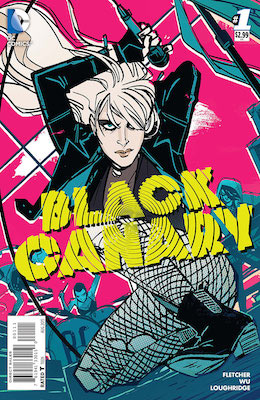
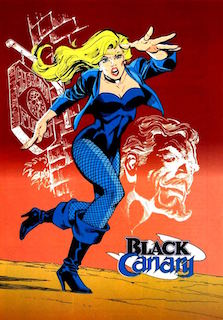
Now she wears a rock star costume – which looks like a shoddy version of the pre-Flashpoint Black Canary costume, goes by the handle D.D., and, oh yeah, is the lead singer for a rock band called Black Canary.
But behind the music, Black Canary is a trouble magnet. Did I mean the heroine or the band? Take your pick. Be it an armed rival rock band crashing a Black Canary concert or a group of overly aggressive “suitors” hitting on women, both figuratively and literally, five of the band’s last seven concerts ended in violence. Ended with D.D. getting into fights with someone at the concert. According to the background information for the current Black Canary series, D.D. is “more comfortable in combat than on stage” and that venues and promoters are “making noise about striking the band from upcoming bills.”
Well I should hope so. Otherwise, there’s a lawsuit waiting to happen.
I mean, let’s assume you’re a club owner thinking of booking Black Canary – the band not the super heroine; you don’t know the lead singer is the super heroine. (Although I don’t know why not. If Black Canary appearing as the lead singer of a rock band called Black Canary and getting into constant fights in which she displayed the same martial arts skills as the super heroine with the same name isn’t an open invitation to piercing her secret identity, it’s only because it lacked an R.S.V.P. card.) Why would you, the club owner, risk hiring Black Canary? Especially when the odds are 5 out of 7 – or 71.43% for the Vegas inclined – that the band will get into a fight which will cause damage to your club or injury to your patrons. Or, more likely, both.
Should that happen, you, the club owner, would have to pay for the damage to the club and would probably have to pay for the injuries to the patrons. Either pay now or be sued by the patrons and then pay later for both their injuries and their attorneys’ fees.
Once the word on Black Canary the band spread – and in these days of social media, the word would spread faster than schmear on a bagel – why would you, or any club owner, risk having Black Canary perform in your club? If your answer is I don’t know, you have what it takes to make a go of it as a club owner. Or in the legal profession. If your answer is I don’t know, that also puts you one up on all the club owners in the DC Universe, who gave Black Canary enough bookings to last through seven issues of her current series.
That, however, is only the first of the lawsuits waiting to happen found in Black Canary # 1. Let’s move on to more serious matters. The band Black Canary is made up of D.D., Lord Byron, Paloma Terrific, and Ditto; plus their manager Heathcliff Ray. I’m not sure how old Lord Byron is but I’m guessing late teens to early 20s. Heathcliff, was a student at Gotham Academy who left the school to manage Black Canary. So he’s a teenager. Probably 18 though, otherwise he couldn’t sign or negotiate legally-binding contracts. Paloma looks to be about 15. And Ditto is a little girl; 10ish. Oh and none of them have any combat or fighting training.
So, naturally, none of them were prepared when weird alien shadow monsters attacked one of their concerts. Black Canary, the heroine not the band, defeated the monsters and learned that they were, for reasons which will, I hope, be revealed later in the series, hunting Ditto.
What did Black Canary do in light of these events? Why she contacted Superman, Batman, the Justice League or some super hero capable of handling alien shadow monsters and let them know what was happening. Then she made sure that Superman, Batman, the Justice League or some hero capable of handling alien shadow monsters was going to protect Ditto from these alien shadow monsters. Right?
Wrong!
No, Black Canary the heroine agreed to continue touring with Black Canary the band knowing that she’d be putting the other members of the band in danger. Not to mention the fans attending their concerts. The only concession to common sense that Black Canary made was to insist that she train the other members of the band in combat; first hand-to-hand and then weapons training.
Because that makes so much sense. Let’s continually put a group of untrained amateurs – at least two of whom are minors – into dangerous situations without anyone to protect them except one super heroine – a lesser-powered super heroine armed with fighting skills and a sonic super scream called the Canary Cry. That’s it for the defense team, Black Canary and four kids who have a total of – what? ten? twenty? – hours training in combat. But no help from Superman, Batman, the Justice League or anyone who would actually be good in a fight against alien shadow monsters. (Hell, at this point, I’d have settled for Ambush Bug.) Not only did Black Canary’s actions court several negligence lawsuits, they were several counts of criminal child endangerment just waiting to happen.
This is not logical. Unless, as Mr. Spock said when he was trying to destroy an android’s logic circuits, logic really is “a wreath of pretty flowers which smell bad.”
Oh and while we’re at it, let’s have this group of untrained kids keep on performing in public concerts in public venues while knowing that they’ll be attacked by alien shadow monsters. That way you can pretty much insure that whenever the alien shadow monsters attack, it will be sometime when large numbers of innocent, and easily injured, civilians will be present. Because, short of shooting a gun into the audience, nothing screams negligence lawsuit like intentionally creating collateral damage. This was the Canary Cry of screaming negligence.
I’ve just gone over this column and found that I’ve given you some incorrect information. What Black Canary did wasn’t, as I said earlier, a lawsuit or three waiting to happen. I was off by a few dozen exponents.
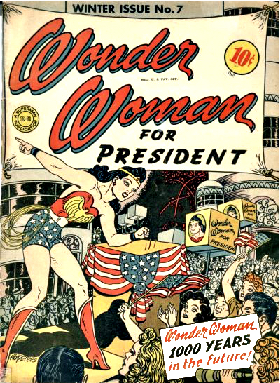 Here’s what gets me about Wonder Woman.
Here’s what gets me about Wonder Woman.
She is, rightfully, symbolic of strong women who can take care of themselves, stand up for themselves, and help others – men and women alike – do the same. These are very good things. She started out before America entered World War II, so you can’t really attribute “Rosie the Riveter” juju to her origins: she was created at a time when most strong women were to be found in movies, and by then almost always in front of the camera and not behind it.
To be sure, there were plenty of other women super-heroes in comics. Some were spin-offs or sidekicks to male superheroes – Mary Marvel, Bulletgirl and the original Hawkgirl come to mind – but others were stand-alone creations: the original Black Widow (1940), Phantom Lady (1941), the original Black Cat (1942), Liberty Belle (1943), and my personal favorite, Miss Fury (1941), the only one of the bunch that was created, written and drawn by an actual woman. Wonder Woman thrived and was the principle reason DC Comics bought All-American Publications for the simplest and best of reasons: she was the most fully realized of them all.
But in lesser hands than those of her creators, she encountered her own glass ceiling.
Wonder Woman got her start in All-Star Comics #8, December 1941, as a nine-page feature backing up the usual Justice Society of America story. It was a bonus for the readers, as pages were added to the issue for the story. No mention was made of any of this on the cover. One month later, her series debuted in Sensation Comics #1 and she was so popular she was awarded her own title several months later.
She would return to All-Star Comics in 1942 when the Justice Society guys voted her in as their first female member, something long denied to Hawkgirl or Liberty Belle or even Merry, Girl of 1,000 Gimmicks (don’t ask). This was only a few months after the publication of Wonder Woman #1, and only 10 months after her debut appearance in All-Star.
Talk about the fast track. But, sadly, it was the fast track to that glass ceiling.
Wonder Woman joined the Justice Society not as a full-fledged member, but… wait for it… as the Society’s secretary.
No shit. While the readers’ moms were working at the defense plant, the phenomenally popular super-heroine was relegated to taking notes about the adventures enjoyed by the men. In fact, just like Rosie the Riveter her position was only guaranteed “for the duration of the war.”
Whereas she occasionally played an enhanced role in the story, Wonder Woman did not become a fully active member of the team until All-Star Comics #38, December 1947, six years after her debut in the same title. Coincidently, that story also offered a guest-shot from Black Canary, who was asked to deliver a message (“everybody else in the JSA is dead”) to Wonder Woman. In turn, WW picked up the bodies of her fellow JSA members – her fellow JSA fellows – and brought them back to life using the Amazon’s Purple Ray, a staple in the Wonder Woman series.
Amusingly, it was Black Canary who saved the JSA members at the end of the story. As a reward… no, she wasn’t made the new secretary… she was given the team’s thanks and a nice pat on the back and was made an honorary member. Three issues later, Black Canary finally was given full membership.
When the Justice League of America debuted in 1960, Wonder Woman was there as a fully involved member of the team. I’d say this represented progress, and I guess it did but those initial stories only had five fighting members of the team, Superman and Batman being “too busy” to join in the fun. That only left four other DC superheroes plus Wonder Woman. But there was no relegation to second-class status for the iconic heroine… and that does represent progress.
It would be a while until women were regularly involved in creating Wonder Woman’s stories, not to mention those of the other DC superheroes which were expanding like amoebas. But, hey, Eisenhower was president. The New Frontier didn’t start until the following year.
As part of my ongoing series exploring today’s creators’ reactions to their comic creations’ successful crossovers into other media, this week I reached out to Steven Grant. His impressive career includes reviving Marvel’s The Punisher, creating characters like Whisper and writing the long running comics industry column, Permanent Damage.
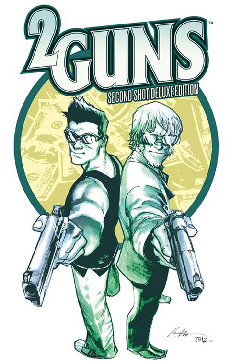 Ed Catto: Your 2 Guns comic was a hit movie in 2013. Can you tell us a little about the process of bringing your comic to the movies, from your perspective as the writer?
Ed Catto: Your 2 Guns comic was a hit movie in 2013. Can you tell us a little about the process of bringing your comic to the movies, from your perspective as the writer?
Steven Grant: Getting a film made from a comic is generally a much longer and more arduous process than most people seem to think. I wrote 2 Guns somewhere between 1998 and 2001, and I had the idea for it much earlier than that. I’d tried selling it for years to various comics publishers, but selling a straight crime comic with no other genre aspirations is a very difficult thing. Finally I had a lull in my schedule and just didn’t want to let go of the notion, so I wrote it anyway. It took a long time. Still couldn’t sell it.
Finally, around 2006, Ross Richie, who I’d known for years, launched Boom! Studios, and he asked if he could publish it, though he couldn’t pay me for it at the time. I wasn’t doing anything else with it, so I said sure. I wanted to see it in print. It was published in 2007. This was right at the time Hollywood started paying a lot of attention to anything published in comics, and Hollywood was somewhat more open to the material – once it had seen print. Prior to that, I’d never been able to rouse any Hollywood interest in the story either, and I had tried – than comics was.
I wasn’t actively involved in any of this, but Ross kept me regularly apprised. Interest grew, studios got involved. I’m told there was something of a bidding war between Fox Atomic – I think it was Fox Atomic, it was one of the Fox sub-brands of the day – and Universal that Universal won, then the person who was involved in that at Fox ended up at Universal so everyone was happy. But even something like that doesn’t guarantee a movie.
A Hollywood deal is basically an unsecured promissory note. Putting a movie together these days is a complicated game requiring the right assemblage of what are now called “elements”: concept, a good production company (established track record preferred), a script by preferably a studio-approved screenwriter that’s good and interesting enough to attract actors with a reputation for “opening” a film (i.e. selling a lot of tickets the first weekend).
Prior to founding Boom! Ross had spent several years working in Hollywood and studying the mechanics, so with some help he was able to navigate the waters. Even at that, the script, cast and crew went through several iterations, and the studio came close to dropping the project a couple of times for Hollywood reasons that had nothing to do with the project itself. Things are always touch and go in Hollywood, even after filming starts.
I think ultimately that 2 Guns got made – and I’m not trying to diminish the many people who worked diligently throughout, like Adam Siegel and Marc Platt of the Marc Platt Co., our production company, who like Ross were also key and ceaseless champions of the project – came down to Mark Wahlberg, who we were lucky enough to land in one of the key roles and who made it his mission to get the film made, bringing in both additional financing when some of our financing fell through (also an incredibly common occurrence in Hollywood) and the wonderful Baltasar Kormákur when the previous director bailed. Baltasar brought such a great visual and stylistic tone to the film. It finally filmed in 2012, four years after the “bidding war,” and hit theaters a little more than a year after that. Trust me, if you’re invested in a film project based on your project, invest in a lot of Maalox because it’s a very bumpy road, and the road to 2 Guns was smoother than a lot of them.
EC: When you saw the movie, were you happy the finished product?
SG: I love the film, but why wouldn’t I? From the beginning, Ross, Adam and screenwriter Blake Masters, who’s a great guy, by the way, were determined to stick as close spiritually to the material as possible. There were changes of course, but you can do so much more in a film than you can on the comics page that I’d’ve been pretty disappointed if they’d stuck strictly to what’s in the book. I do think they kept everything that was important in and to the story. Blake in particular (and Baltasar later) picked up on 2 Guns being a very deadpan comedy. That’s how I always thought of it. Ross and I would have long arguments about that, but I wrote it so of course I was right. I think Blake did a wonderful job. Like I said, I love the film, and considering how many comics guys crab about what Hollywood did to their work, I can’t tell you how happy I am to be able to say that. I didn’t see the film until the premiere, and was terrified I’d have to lie my ass off about liking it afterwards, but thankfully it never came to that. I not only love the film and still find it tremendously watchable, I like their ending better than mine.
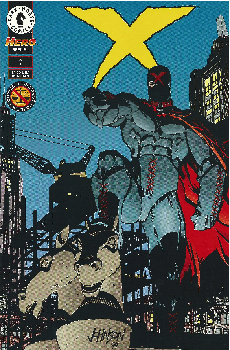 EC: In the ‘90s you created a character called X for Dark Horse Comics. What sparked the creation of that character?
EC: In the ‘90s you created a character called X for Dark Horse Comics. What sparked the creation of that character?
SG: I didn’t create X. For several years, Dark Horse had been quietly developing a superhero universe concept in house, and X was one of their linchpin characters. What happened was a guy named Jonathan Peterson was an editor at DC and asked me to write some Deathstroke issues for him, then I started doing other work for him as well. DC was big into “reimagining” old characters, and they had one called Americommando in the ‘40s that I thought was both one of the greatest and worst names in the history of comics, so I created a political thriller concept around it that was probably a bit more left-wing than DC would’ve been comfortable with.
Then Jonathan left and, as is often the case, the projects he’d been setting up, including several of mine, evaporated. I retooled the concept, retitled it Patriot X and pitched it to Dark Horse, which had recently picked up the Badlands project I’d started at Vortex Comics before they hit the skids. Mike Richardson really liked the Patriot X concept, but asked if I could name it something else because they had this character X they were doing for their superhero universe. So I retitled that project Enemy, then Mike asked me to write X as well.
EC: I always remember X being called “the Batman from Hell.” Was that a fair assessment?
SG: Sort of. I didn’t create X but I did kind of recreate it. Their original concept for the character was – and this is badly bowdlerizing it into convenient shorthand – Batman dressed as a Mexican wrestler. I tuned him up into the relentless, fixated psychopath of the first X series. I don’t recall whether the “Zorro” gimmick – one strike as a warning, the second strike (completing the X) as death sentence – originated with me or with Mike, Randy Stradley and Chris Warner, the original architects of the character. Anyway, yes, Batman was key to their conceptualization of the character, but I tried my best to keep specific parallels to Batman beyond the unavoidable out of it.
EC: At one point it looked like X was headed to the Fox Network for a TV series. Can you fill us in on what happened and what where your reactions to that then?
SG: If X was ever a Fox pilot, I never heard about it. They were trying to get it done as a film for a while that I wrote a very bad screenplay for (I really didn’t know what I was doing at the time) that was quickly trashed. You might be thinking of Enemy. David Goyer and Columbia approached Dark Horse about getting the rights for a potential TV series after the book came out. I think it might’ve been David’s first producing job, whereas previously he’d just been a screenwriter. I could be misremembering. Mike was involved too as an executive producer, since he’d already had The Mask as a TV series. They pitched it to Fox, which paid for the pilot. I’ve seen it; I’ve got a copy around here someplace I’m not supposed to have. It’s okay. I’m not sure what happened. I know it was on Fox’s schedule for at least a few days prior to them announcing the schedule, but when they announced it wasn’t. I’ve heard various explanations from different people. It basically boils down to “It’s Hollywood.” Things are go, then they’re suddenly not go. Nothing’s real until it’s real.
Of course, I was thrilled they wanted to make a series. I had nothing more I especially wanted to do with the character. It was one of the first times I thought completely in terms of the story rather than a franchise, so a TV show meant I could make lots of money from it and they’d be the ones worrying about a franchise.
I doubt I’d’ve been very involved in it. Network TV didn’t pay much upfront then – not sure what the terms are these days but I doubt they’ve changed much – then you get a little chunk of change for every episode that airs (with some restrictions I forget), but as creator you don’t make a lot of money until the show goes into syndication, meaning it had to stick around for five to seven years, which are slightly better odds than winning the lottery, but not by a lot. But I would’ve liked to have seen it on TV in any case.
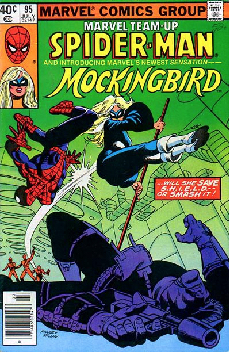 As it turns out, Mike and I have recently been in discussion and I’m probably bringing back Enemy at Dark Horse next year.
As it turns out, Mike and I have recently been in discussion and I’m probably bringing back Enemy at Dark Horse next year.
EC: You also created the Marvel super heroine, Mockingbird. What’s the ‘secret origin’ behind her creation?
SG: That was one of my early on things, when I first arrived at Marvel. When you go to a company like Marvel, everything’s niched. It’s very difficult to find something to put your stamp on. I wanted my own characters to play with, and to do that I had to create them. Mark Gruenwald, who I quickly became friends with because we both originated in Wisconsin, was assistant editor of Marvel Team-Up at the time – that book jumped back and forth between editors like crazy, if I remember correctly – got me assigned a bunch of fill-in issues. Marvel traditionally struggled with deadline problems, so they regularly assigned fill-in issues. I couldn’t get a regular book there but fill-ins kept me alive and taught me versatility, if nothing else.
Mark and I concocted a mini-series within Marvel Team-Up (which largely specialized in isolated stories) set in Los Angeles, and to wrap up that arc. Influenced by the mid-‘70s House investigations of illegal activities by the CIA, I’d pushed several times without success for a Nick Fury Vs. SHIELD idea, and wanted to incorporate that in a story suggesting SHIELD might not be quite the good guys they’d been made out to be. Despite my own failure, this obviously wormed its way into the creative psyche up there, as Nick Fury Vs. SHIELD was done some time after I was mostly divorced from the company.
I’d run across the Huntress character who’d briefly appeared in a Marvel magazine, but by then DC had a character named The Huntress, so Mark and I rechristened her Mockingbird and I retooled her shtick into something I could work with. The main response was fan outrage that Marvel Team-Up had debuted a character rather than team Spider-Man up with an existing one.
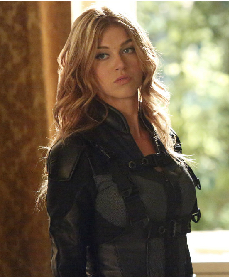 EC: I’m anxious to hear your reactions to seeing Mockingbird on the television show, Marvel’s Agents of S.H.I.E.L.D.
EC: I’m anxious to hear your reactions to seeing Mockingbird on the television show, Marvel’s Agents of S.H.I.E.L.D.
SG: I’ve only seen the first couple episodes she was in – I have the rest on DVR but haven’t had time to watch – but loved her first appearance. Adrienne Palicki works fine in the part, and I thought the shtick was great, very much in keeping with the espionage angle I always wanted for her that Marvel had mostly abandoned. I take it all as vindication, especially if ABC puts her in her own series, which I understand is still a strong possibility.
A funny thing: when I created Mockingbird, I came up with the interlocking staves as her key weapons that could be used in various ways: individually as two-fisted clubs, as climbing picks, locked together as a vaulting pole, etc. I can’t swear by it but don’t recall that being a thing before her.
Now Mark, at heart, was always a DC Comics fan first, and had this dream of creating a Marvel Comics analog of The Justice League. In that scenario, he envisioned Mockingbird as Marvel’s Black Canary, and hooked her up with Hawkeye (Marvel’s Green Arrow) at the first opportunity. I don’t especially like the whole concept of analogue characters (re: X) and tried to keep away from it. So a TV version of the Black Canary shows up on the second season of Arrow, and what do I see? Her key weapons are interlock staves that can be used in various ways: individually as two-fisted clubs, etc… They lifted Mockingbird’s bit and gave it to the Black Canary. Full circle.
EC: Gerry Conway has detailed his frustrations with the corporate policies dictating recognition and compensation for characters he created for DC Comics. Can you reveal your own experiences, specifically as they relate to the Mockingbird character?
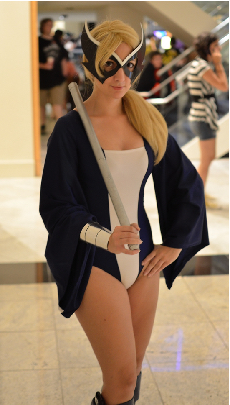 SG: They were nice enough to start crediting me on every episode she’s in, though they kindly don’t mention what anyone’s credited for. I haven’t seen any checks yet. Those are my experiences so far. We’ll see what happens. But I don’t question that Marvel/Disney own the character. I’m not sure yet what their policy on these things is.
SG: They were nice enough to start crediting me on every episode she’s in, though they kindly don’t mention what anyone’s credited for. I haven’t seen any checks yet. Those are my experiences so far. We’ll see what happens. But I don’t question that Marvel/Disney own the character. I’m not sure yet what their policy on these things is.
EC: Do you feel today’s creators are better prepared to deal with creation of their characters and their possible success in other media?
SG: Probably not, unless they’ve had a lot of personal experience. I’ve noticed by and large comics talent all think they’ll be the exceptions, and don’t seem to get what a minefield media is. It can be navigated but in general it’s all hard choices and risk, and most don’t understand the process and have wildly unrealistic expectations to both extremes.
I’m not suggesting people should start out cynical – that’s as good a way to kill of good opportunities as any – but it pays to educate yourself on the risks and pitfalls, and find out how things are really done rather than swallow the snake oil usually peddled as “how Hollywood [or anything, really] works.” A good education in the workings of whatever field and realistic expectations are the best shields against disappointment and bitterness anyone can get, and the best ways to increase the odds of success.
EC: Great insights and stories. Thanks for your time, Steven.
I guess I should put some kind of SPOILER WARNING right here, up front. Isn’t that a rule?
So Arrow has made a devil’s deal with Ras Al Ghul and, in exchange for his sister’s life, agreed to become one of Ras’s League of Assassins. What next? I’ll be watching the CW on Wednesday night to find out, but in your time zone, that was yesterday.
The storyline is based on one that appeared in Batman some years ago. Adapting a Batman plot to the Arrow really isn’t much of a stretch – the characters, though impressive, are both thoroughly human and operate pretty much on the same scale. (I’m tempted to call it “mythic” but that might be edging toward pomposity so let’s settle for “primordial” and get on with it. Or is “primordial more pompous than mythic?)
The Arrow creative folk are basing their drama on the old Batman continuity to which I contributed, but they’re taking the basic ideas further and in the process making improvements. As I was watching the show I wondered if those improvements occurred to me, way back when. Almost certainly not. Why? Well, uh…maybe because they break, or broke, some of the rules of superhero writing. And where, exactly, did I learn these rules? Were they written down, maybe on the walls of the publishing office? Given to me as part of a “welcome aboard” package? Or did some paternal executive, kindly eyes twinkling behind rimless glasses, take me aside and explain the facts of life to the new kid?
Nope, nope, and nope.
My best guess is, I intuited them, or figured them out, from the comic books I’d read. This, obviously, was how things were done. I’m not talking about sex or violence – we knew those had to be approached gingerly because of the times we were living in and that was no problem; I didn’t, and don’t, yearn to splash hormones and blood across the pages of comics. (The mandate, as always, is if the elements in question don’t serve the narrative, they probably don’t belong in the story.) No, the kind of unwritten taboo we’re discussing might have been broached if I’d had my masked vigilante reveal his real identity to the world, or had him ally with the villain, as Arrow apparently did last week.
Would rebellious li’l ol’ me have gotten away with such transgressions? Hard to say. Might have depended on who I was working for. Editors have their individual foibles. And there seemed to be no one way of reading and interpreting the Comics Code, the industry’s self-censoring tsar which was, presumably, the real rule setter. But nothing in the Code’s protocol mentioned double identities (though there was, if memory serves, a provision that dictated that the bad guys had to be in custody by story’s end.
(I did get away with depriving Green Arrow of his fortune and sending both the original Batwoman and Black Canary’s husband, Larry Lance, to their eternal rewards. Maybe nobody noticed.)
I guess the overarching commandment was: This Shall Not Change.
Some form of that is probably still The Commandment, but the enforcement is much more generous.
Alas, there was no rule, written or unwritten, that guarantees a great story every time out. There still isn’t. If I’m wrong about that, somebody please let me know.
Green Arrow was never really a loner. When he first appeared in More Fun Comics #73 he already had a young partner whose nom de arrow was Speedy and whose other name was Roy Harper. As GA – other-named Oliver Queen – sauntered through the years, he formed alliances with another greenish hero, Green Lantern, and, maintaining the color-motif, Black Canary, with whom he had a full-out, bells-and-whistles romance. And he was a member in good standing of the Justice League of America, comics’ first…what? – superhero club, I guess.
So no, Ollie, as we are pleased to call him, was never a loner, but I never thought of him as a clubman, either. He was this guy who did what he did and had occasional friends and associates.
Now he is enjoying what are undoubtedly the largest audiences of his life as the title character of a network television series. For whatever (corporate?) reason he’s lost an adjective and is now known as plain old Arrow. And Roy Harper – you remember Speedy – is still in the picture and so, sometimes, is Black Canary and then there’s John Diggle and a cop friend and the lovely computer whiz Felicity and, recently, a guest superhero in the person of The Flash and…Golly! It must be getting crowded in the Arrow’s subterranean headquarters, there in Starling City.
Well, what did we expect? It’s television and television drama, with no current exception that I can think of, is built around families. These are not necessarily biological families – in fact, they are seldom that. But they have a clear family dynamic.
Cop shows are good examples: There’s the father/mother figure – often a bit grumpy, and usually bearing an elevated rank – and sometimes an aunt/uncle avatar – those cadaver-cutting medical folk, for instance – and occasionally the young guy/gal who, while lovable, is not yet fully formed professionally – and don’t we adore the youngsters in the house? – and finally, and most important, the brother-sister combos, the heavy lifters who get the jobs done.
You could find a family on the flight deck of the Starship Enterprise and in the streets of Dodge City, and in the corridors of the Jeffersonian, whatever that is. I’m not a fan of sitcoms, but there are probably some in laughtrack land, too.
Way, way back in the early 1940s, the producers of the daily Superman radio program added young Jimmy Olsen to regulars Clark Kent, Lois Lane and Perry White and he’s been a part of the – yes! – family ever since. Those loner private eyes that were in vogue back then didn’t know that their days were numbered.
Now, we have Arrow and his cadre of virtuous ass-kickers saving Starling City. Literally: in a recent episode, that’s what they said they did – saved the city.
But do they pose for group photos at Christmas?
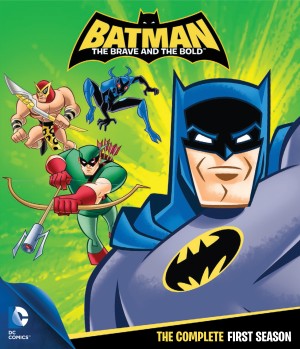 Batman in media has often been a victim of budgets and a fickle public’s tastes. His success or failure has also impacted the comic book incarnation. For example, after the camp live-action series crashed in 1968, the comic sales plummeted, freeing editor Julie Schwartz to take things back to the beginning and reinvent the gothic look and feel which evolved into the 1980s’ grim and gritty comics. Similarly, after a successive series of dark, moody and brilliantly execute animated series, it was most definitely time for something fresh.
Batman in media has often been a victim of budgets and a fickle public’s tastes. His success or failure has also impacted the comic book incarnation. For example, after the camp live-action series crashed in 1968, the comic sales plummeted, freeing editor Julie Schwartz to take things back to the beginning and reinvent the gothic look and feel which evolved into the 1980s’ grim and gritty comics. Similarly, after a successive series of dark, moody and brilliantly execute animated series, it was most definitely time for something fresh.
Along came Batman: The Brave and the Bold, a bright, colorful, action-packed series that was a sheer delight to watch. This was a Caped Crusader who worked well with others, didn’t brood a lot but took his job far more seriously than his costumed companions. He operated in a universe where heroes and villains from across the DC Universe operated, letting animators stick in brilliant cameos and actually reinvent some of the characters most in need of a personality. Among the latter was the bearded blowhard Aquaman, ready to tell a fish story, naming the adventure with an ego-centric flourish.
Warner Archive has done us all a favor by collecting the 26-episode fist season and putting it all on two Blu-ray discs for an affordable price. The premise often involved a pre-credit sequence as the Gotham Guardian finished a case with one hero before moving on to another escapade with another. As with eponymous comic it was based on, some characters reoccurred more than others thanks to their popularity such as Green Arrow, whose rivalry with Batman for gear and gadgets made for nice humor. The current incarnation of Blue Beetle was seen as an amateur in need for tutelage and we could see him grow in confidence across the run.
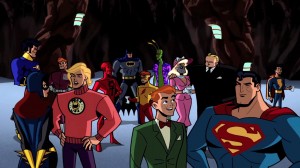 Clearly the writers, directors, animators, and voice cast had a marvelous time and it came through with every episode. The character designs came from across DC Comics’ decades long run so Black Canary look as Carmine Infantino first drew her in the 1940s while Plastic Man was at his loopiest. It was refreshing to see the JSA heroes fighting as veterans (notably the pugilistic cracks from Wildcat) while long-simmering character bits such as those between Batman and his wards rang true.
Clearly the writers, directors, animators, and voice cast had a marvelous time and it came through with every episode. The character designs came from across DC Comics’ decades long run so Black Canary look as Carmine Infantino first drew her in the 1940s while Plastic Man was at his loopiest. It was refreshing to see the JSA heroes fighting as veterans (notably the pugilistic cracks from Wildcat) while long-simmering character bits such as those between Batman and his wards rang true.
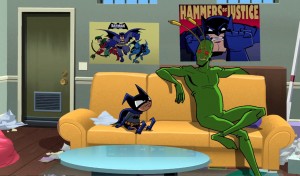 A standout episode was the musical “Mayhem of the Music Meister!”, with the incredibly talented Neil Patrick Harris voicing the title villain. And like so many other installments, this one featured not just one partner but a small army including Green Arrow, Aquaman, and. Black Canary.
A standout episode was the musical “Mayhem of the Music Meister!”, with the incredibly talented Neil Patrick Harris voicing the title villain. And like so many other installments, this one featured not just one partner but a small army including Green Arrow, Aquaman, and. Black Canary.
Given the Earth-3 villains now running amuck in Forever Evil, it’s fun to see their animated counterparts in the two-parter that closed out the first season — “Deep Cover for Batman!” and “Game Over for Owlman!”.
By some chance you missed this when it aired on the Cartoon Network, or you want a break from the sturm und drang of the current New 52, this is a treat you want.
There is a lot coming at us on this year’s ARROW including introductions of The Black Canary and The Flash, but first the characters have to cope with the ramifications of events from last season. Star Stephen Amell and the cast talk about how it’s all evolving into what may be a different show. Meanwhile, he was hand picked to get a late night slot after CONAN on TBS. Pete Holmes has a show that needs fan attention.
THE POINT covers it 24/7! Take us ANYWHERE! The Point Radio App is now in the iTunes App store – and it’s FREE! Just search under “pop culture The Point”. The Point Radio – 24 hours a day of pop culture fun for FREE. GO HERE and LISTEN FREE on any computer or on any other mobile device with the Tune In Radio app – and follow us on Twitter @ThePointRadio.